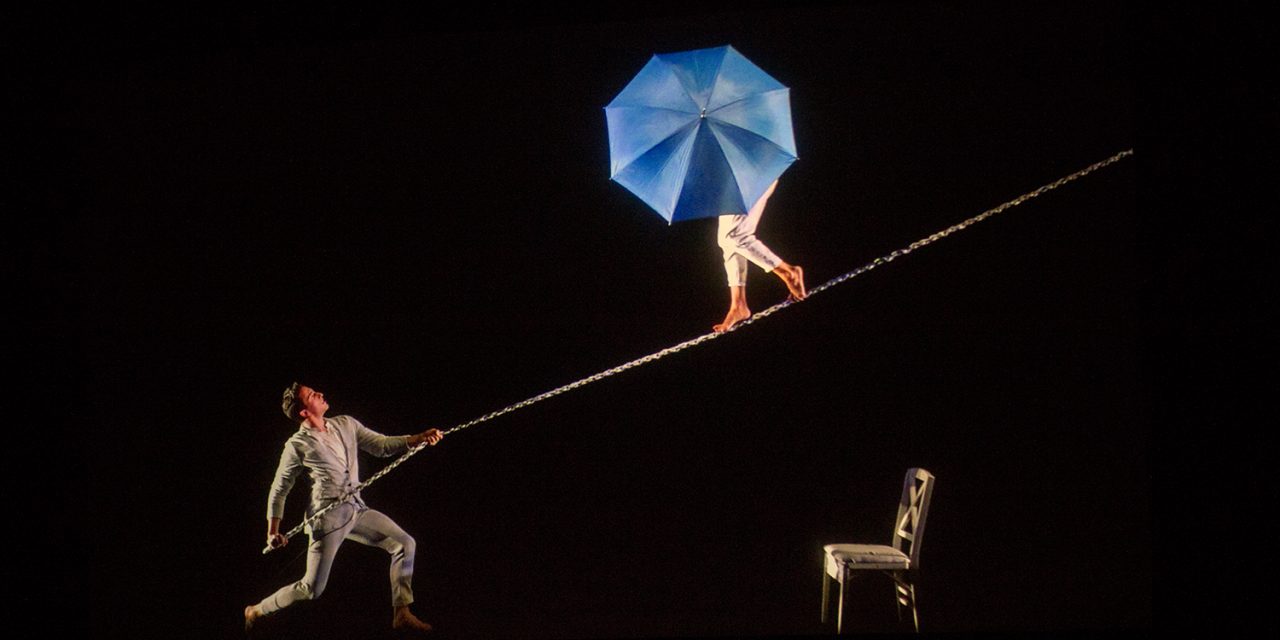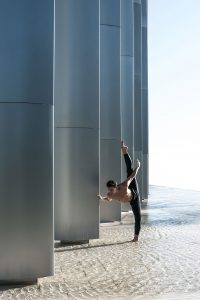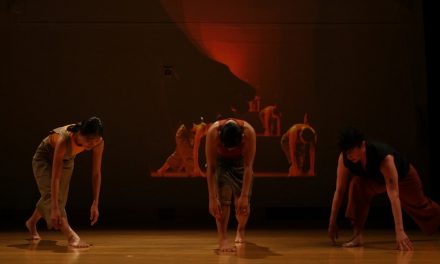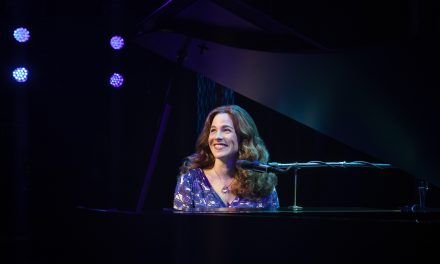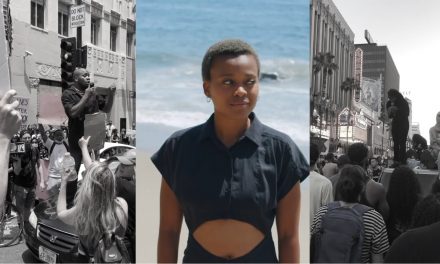Now in their fourth year of residency at The Soraya, Aspen Santa Fe Ballet’s latest work was a three-part undulating trip through alternative reality. Composed of distinct pieces by three different choreographers, the work was bold and impressionable. Each segment stood wonderfully alone but blended well together to create a cohesive show. The presentation may have worked better if it were ordered differently, but its sequence did not fully compromise the overall dreamy ambiance in which it engulfed the audience as they were enticed to dive deeper into the production’s layers.
Already known in the dance community for their strides in contemporary and modern ballet, ASFB reinforced their reputation as an innovative company with their January 19 production, which showcased pieces from their repertoire never before shown on CSUN (California State University Northridge)’s artistic stage.
Alexander Ekman’s Tuplet kicked off the night. First performed by Cedar Lake Contemporary Ballet in 2012, the work was a live spoken and movement–based discussion about rhythm. Mikael Karlsson and Victor Feldman’s beats (combined with a small sample of “Fly Me to the Moon”) added a great deal of power to the dancers’ a cappella, beatboxing score. The work began before the lights went down with the dancers humming, clapping and vocalizing a steady “pa, pa, pa”, which filled the air to create a flowing melody. Moments later, a shadowed Anthony Tiedeman appeared against an all-white background and began swaying to instructional beats: “ta, ta, ta, bom, bom”. He was swift, smooth, bouncy, and stopped on a dime, which gave the impression that his body was literally being controlled by the melody. Between pauses, he would stand stunned, quickly fixing his shirt or waiting to move, before the voice would once again start up its dictation of rhythm. As it came back on, Tiedeman uncontrollably stumbled backward and jerked around the stage, never quite losing his grace or composure.
The next scene revealed six performers—Tiedeman, Katherine Bolaños, Seia Rassenti Watson, Evan Supple, Pete Leo Walker and Joseph Watson—standing on what appear to be lit patches of carpet. The concept was the same as with the silhouetted solo—a juxtaposition of visual and auditory pulsations. Thicker, heavier cadences were used in this section. The overhead voice became more distorted as a loud fuzzy cymbal crash connected its deeper, blunter sounds together to create a hip-hop–like rhythm. Dressed in dark blue, the ensemble bent and twisted their bodies in response to the omnipresent voice. Arms and elbows jutted outward, heads shook to staccato laughing, torsos folded in on themselves like accordions, and statue-like poses were struck between transitions. Despite the visibly running thread through each dancers’ choreography, the performers were able to show off their own style through the execution of their movements, particularly in moments when their motions deviated from one another. Standouts included Tiederman, Watson and Walker, who best hit the sweet spot between robotic and natural. This especially became evident in a presentation of “their” names (which may have just as easily been confused for their real names if one failed to look at the program), a roll call during which each syllable of every alias was assigned a quick beat. For instance, Watson always responded to Samantha Mohr with sassy hip thrusts to represent her first name and an outward hand gesture for her last. The flow the troupe created as the names were mixed together formed another twisty dance.
Tuplet continued with two greatly juxtaposing sequences. The first was a return to the black and white motif shown in Tiedeman’s solo. An instrumental, jazzier version of “Fly Me to the Moon” played overhead, while something that resembled a pillow fight took place on stage as the performers swung their rugs around at each other. Each dancer, one barely distinguishable from the other, skipped and hopped across the set in a sudden flurry before the light softened and sharpened their features. The second was a blue-toned projection with overlapping clips of musicians playing in slow motion behind the dancers who stood in front of the images and used their bodies as instruments, clapping their hands and slapping the inside of their thighs to produce a new measure. This section was militaristic and almost unnerving. The piece concluded with a spoken lecture about rhythm during which the six partially acted out a conversation about its flexibility and consistent presence in the world around us—a concept Ekman and ASFB made clear throughout the piece.
Fernando Melo’s Dream Play (2017) was next and though it continued the abstract theme, it tore further away from reality with a presentation that channeled nuances seen in French art noir films. Performers Bolaños, Watson, Supple, Tiedeman, Walker, Watson, Jenny Winton, Sadie Brown, Jenelle Figgins and Austin Reynolds were featured in a multi-sectioned piece wherein they maneuvered horizontally on the floor of the stage in careful, calculating movements as though sifting through a mystical haze or under water. An overhead camera made them appear upright, its deep, blackening lens minimizing light and blurring out details behind them so that the focus was on their “steps” and props.
The show took on a dual-angled perspective which also gave audiences a chance to see the crew behind the curtain, as those dancers who were not featured on camera sat on stage and meticulously took turns contributing to the shot by way of inching down rope, rolling down balls for the performers to “juggle”, or pushing another dancer into frame as they “floated” downward or away from the ensemble members in view on a wheeled plank of wood—the sound of their wheels creaking along the floor planks pleasantly added to the scene’s self-awareness.
The first shot consisted of Tiedeman sitting in a light-colored suit on a chair, from which he rose and began to walk away. This was achieved with the addition of a barely visible black platform placed higher up on the stage along which the performers could place their feet to maintain the illusion of walking in a straight line. Tiedeman especially was able to work through some of the stiffness involved in walking, turning, sitting horizontally and added a touch of grace to his gait, slowing down the extensions of his arms in order to move cohesively and to emphasize the dreamy and fantastical quality of the piece.
A love story was formulated between him and Janelle Figgins, who appeared to him in a puffy-sleeved white top as a tightrope walker with a blue umbrella. Later, Figgins was shown dancing with another lover—Supple. Their story included a lot of upward, gravity-defying bouncing, which recalled the sensation of walking on the moon. Their separation, though sad, resulted in protagonist Tiedeman finally getting the girl, a happy ending to a mostly-melancholic piece, which explored loss and loneliness.
Rounding out the dance were groups of ladies who appeared between segments with umbrellas or alone to imitate a synchronized swimming routine by bending their bodies into shapes along the floor. Though not entirely necessary, their addition added more whimsy to the piece, especially in combination with Erik Satie and Frédéric Chopin’s soft lullaby compositions tickling in the background. The clever presentation had viewers perking up in their seats to watch the contrasting panoramas unfolding simultaneously and garnered the loudest applause at the end. Dream Play was undoubtedly the most enchanting of the three pieces.
1st Flash, which had the least amount of description to it within the program, was last. Choreographer Jorma Elo’s fast-paced beauty was by far the most energetic of the three and may have worked better as the introduction to ASFB’s show as opposed to the finale, its quick choreography jolting the audience, before they slowed things down with Dream Play, then concluded with Tuplet. Ekman’s discussion of rhythm would have been especially effective after the audience had the chance to see the other two pieces play with it so liberally.
Regardless of placement, 1st Flash did fit in with the theme because it became an exercise in timing. It broke the typical conventions dictating that the dancing match the music (Movement 2, Adagio di molto, and Movement 3, Allegro, ma non tanto from Jean Sibelius’ 1905 Concerto for Violin and Orchestra in D-Minor, Opus 47) by often starting the routine before the melody began playing or continuing the movement after it had ended.
Elo’s piece was first performed by Nederlands Dans Theater in 2003. Long and rather intrinsic, much of it also carried a romantic overtone to it, with plenty of pas de deuxs, predominantly in scenes where the track’s violinist played solo. Swim-like kicks were prominent throughout, as were moments of total disconnection from the music, suggesting that the soundtrack worked as a suggestive guideline for the dancing and not as a metronome the performers were bound to. It was interesting to see when the two would part ways and how long it would take for the two components to synch again, especially as the troupe—Brown, Bolaños, Tiedeman, Walker, Watson and Winton—did the same with one another. Backward steps, wind milling arm rotations, shifts in direction and sudden rushes onto and off of the stage kept viewers on their toes. It was hard to know what to expect, but the chemistry between the dancers was exciting and remained solid throughout.
ASFB put together a smart evening of dance for their return to the CSUN stage. Artistic director Tom Mossbrucker and executive director Jean-Philippe Malaty’s forays into unconventional ballet continue to captivate and, based on the crowd’s reaction alone, ensure that Angelinos will welcome them back again next year.
For more information on the Aspen Santa Fe Ballet, click here.
For more information about performance at The Soraya, click here.
Featured image: Anthony Tiederman, Seia Rassenti – Aspen Santa Fe Ballet’s Dream Play – Photo: Jordan Curet

